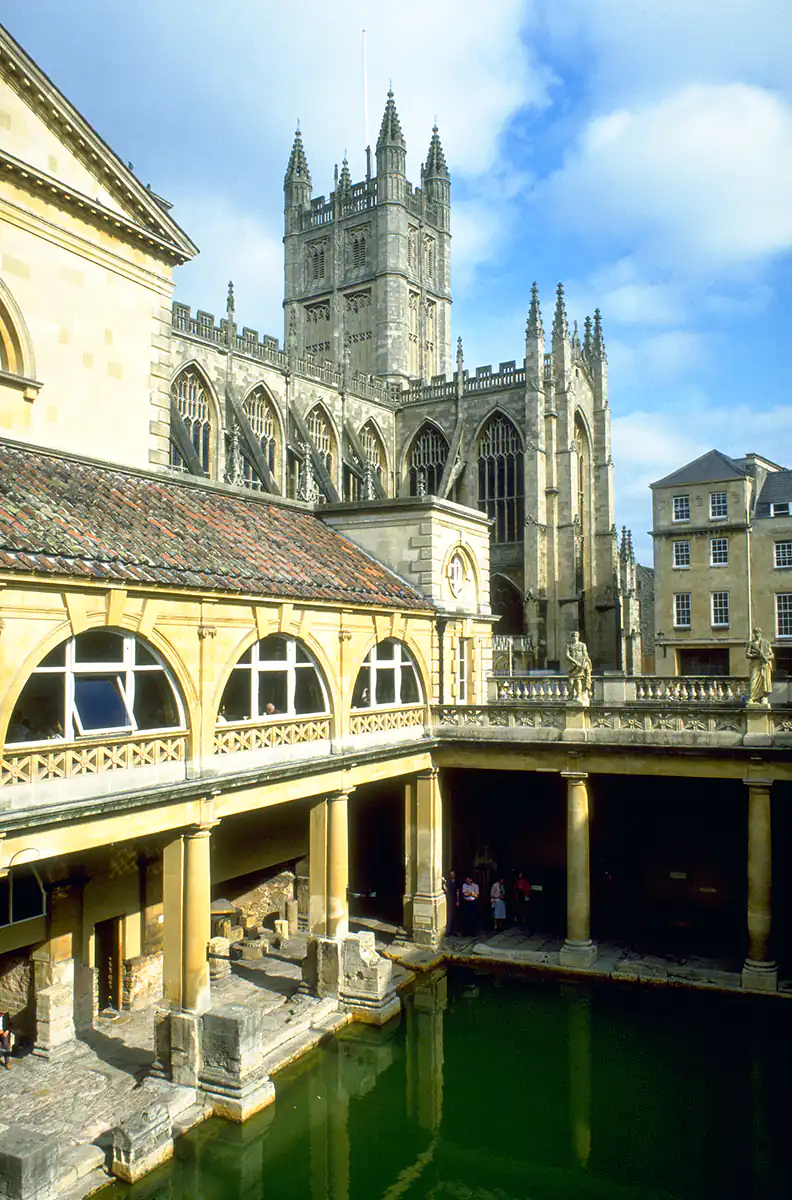Bath
Archaeological excavations have revealed that the human use of the hot mineral springs at Bath began at least 10,000 years ago and has continued to the present times. First frequented by Neolithic hunter-gatherer tribes, the springs were later revered as sacred by Celtic, Roman, and Christian peoples. The Celts, who arrived in England around 700 BC, erected what are believed to be the first shrine structures at the springs. Dedicated to Sulis, a goddess of water, the shrine was a religious center for much of southwestern England. Soon after the arrival of the Romans in England in 43 AD, the Celtic shrine was taken over, and the goddess Sulis was identified with the Roman goddess Minerva as a healing deity. Beginning sometime around 65 AD and continuing for nearly four centuries, the Romans constructed increasingly elaborate bathing and temple complexes at the springs.
The main spring, bubbling out of the ground at a rate of a quarter of a million gallons per day and maintaining a constant temperature of 120 degrees Fahrenheit (49 degrees Centigrade), was, however, far more than just a source of hot water to the Romans. It was a sacred place where mortals could communicate with deities of the underworld and seek the assistance of the goddess Sulis-Minerva and the god of healing, Asclepius. Archaeological excavations at the bottom of the spring have brought to light a remarkable collection of sacred votive offerings thrown by worshippers into the waters. Also, from the spring's bottom, over 12,000 coins - spanning the entire Roman period - have revealed that tossing coins into a spring to accompany a wish is a universal and ancient human behavior. The numerous bathing pools were fed with a constant flow of water delivered by lead pipes, which still function today. The largest bath was lined with 42 great sheets of lead, the combined weight exceeding 8 and 1/2 tons.
This tremendous healing shrine of Aquae Sulis was not to last, however. Following the departure of the Roman legions from Britain early in the fifth century AD, the city and its splendid temples and baths swiftly declined. Over time, the baths were covered by the relentless silting of the spring, and only the fallen temple of Sulis-Minerva marked the ancient sacred site. Yet the town was not abandoned. Instead, it continued to grow, and by the seventh century, the first Christian structure had been established upon the ruins of the Roman temple. For the next twelve hundred years, a succession of churches rose and fell upon the hallowed ground, with the currently standing abbey built between 1499 and the mid-17th century. The hot springs, while never again receiving architectural development equal to that of the Romans, were continuously used throughout the medieval period.
By the beginning of the 1600s, the springs had begun to attract royal and aristocratic families intent on 'taking the cure.' By the 1720s, Bath was on the way to becoming a highly fashionable spa. With this rise in the popularity of the springs and a concurrent need for more bathing and housing facilities, construction excavations began, which resulted in the discovery of ancient Roman foundations. Archaeological excavations have continued to the present day, and Bath now boasts a Roman monument unparalleled in northwestern Europe. Scientific studies of Bath Spring's waters have revealed 43 different minerals, including iron, magnesium, potassium, copper, and radium. The prehistoric, Roman, and early Christian people using the springs had no way of determining the nature of these minerals, yet nonetheless, the springs have been revered as a healing site since time immemorial.
For additional information:

Martin Gray is a cultural anthropologist, writer and photographer specializing in the study of pilgrimage traditions and sacred sites around the world. During a 40 year period he has visited more than 2000 pilgrimage places in 160 countries. The World Pilgrimage Guide at sacredsites.com is the most comprehensive source of information on this subject.

